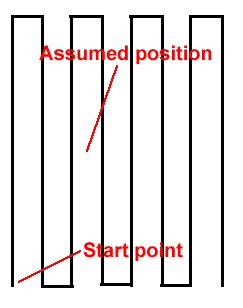Search patterns for lost crew members 2.
A second approach that is more useful when the area of the casualty is not very accurately known is to use a square zig zag search pattern.
In this case, start from a point to one side of the casualty's assumed position, then run one long leg in an easy direction. This leg should be sufficient to ensure that the area around the assumed position is well covered.

The long legs could be 1M length, the short ones short enough to ensure a good overlap of visibility on subsequent legs.
At night, vision will be aided by the careful use of white parachute flares to illuminate the area. Alternatively, a casualty is easiest seen against the light of the moon or shore lights.
This technique seems to be the best when the position of the casualty is not accurately known.
Sailtrain.co.uk is free to use, but if you feel you would like to contribute to the running and development costs you can donate via Paypal:

